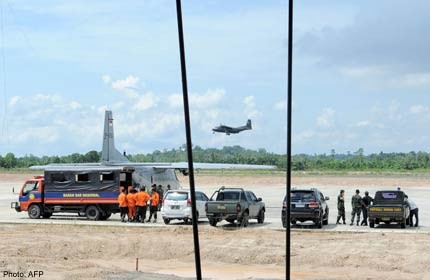Jakarta to revamp military, with an eye on hot spots

INDONESIA'S military will revamp its structure to better manage potential hot spots, a move officials say is prompted by the raised prospect of conflict close to the country's borders and territorial incursions.
Under the changes, which President Susilo Bambang Yudhoyono is expected to announce later this year, up to four joint area defence commands will be set up.
These commands will integrate army, air force and navy equipment and troops and allow them to better respond to developments in flashpoints, The Jakarta Post reported on Wednesday.
The hot spots are: Aceh and Papua over separatist concerns and their strategic locations, the Natuna Islands in the South China Sea, and Atambua, which is close to Timor Leste and Australia.
The paper cited Defence Minister Purnomo Yusgiantoro as saying the new structure "will also serve as a deterrent".
The commands will cover western, central and eastern Indonesia, as well as Java. The locations of their headquarters have not been announced.
The move comes amid regional concerns over a stepped-up Chinese presence in the South China Sea, and as countries including Malaysia and Vietnam beef up their naval presence near the disputed waters.
Last week, Indonesia lashed out at Australian incursions into its waters to turn away asylum-seekers. Canberra has apologised.
On Wednesday, Coordinating Security Minister Djoko Suyanto stressed that Indonesia would step up sea patrols to its south-east, and said the Australian government had to understand Indonesia's sovereignty.
Dr Abdul Rivai Ras, head of maritime studies at the Indonesian Defence University, said: "The command structure is more efficient and effective in deploying military resources. It also has political value."
The new structure, he added, is designed based on the dynamic changes to the region's security environment.
Dr Purnomo told Indonesian media editors each command will be headed by a lieutenant-general who will have the authority to act without going through military headquarters in Jakarta. The commands will also be in charge of a fleet of warships, fighter planes and army units.
A similar integrated command system existed up to the mid-1980s before it was dismantled following a reorganisation.
Stable economic growth in recent years has seen Indonesia raise its defence spending to 83.4 trillion rupiah (S$9 billion) this year, with a greater emphasis on upgrading ageing hardware.
The marine corps will be expanded this year. In March, Dr Yudhoyono is scheduled to inaugurate the 10th marine battalion, with an initial 600 officers, in Setokok, 4km south-east of Batam.
A team is also set to fly to Moscow soon to work out the purchase of 12 Russian Kilo-class missile-armed submarines.
But even as officials seek to better prepare for the possibility of conflict, they are trying to step up efforts to build trust.
In late March, the Indonesian navy will host a multilateral exercise in the waters around Batam and the Anambas and Natuna Islands. All 10 ASEAN members and their regular partners, including China, Japan and the US, are taking part. Australia, with whom Indonesia downgraded military exchanges over a spying scandal last November, is not on the list.
Four joint area defence commands in hot spots
JOINT area defence commands, known as kogabwilhan, will be set up to cover what Indonesia's Defence Ministry has described as flashpoints or strategic areas.
ACEH: There has been fear of separatism resurfacing in the province. It is also strategically located at the mouth of the busy Strait of Malacca.
NATUNA: The oil- and gas-rich islands in the South China Sea are close to waters where China is in a territorial dispute with Brunei, Malaysia, the Philippines, Vietnam and Taiwan.
PAPUA: The eastern-most province has been plagued by separatist conflict for years.
ATAMBUA: This town in West Timor is located close to Timor Leste and Australia.
zakirh@sph.com.sg

Get a copy of The Straits Times or go to straitstimes.com for more stories.